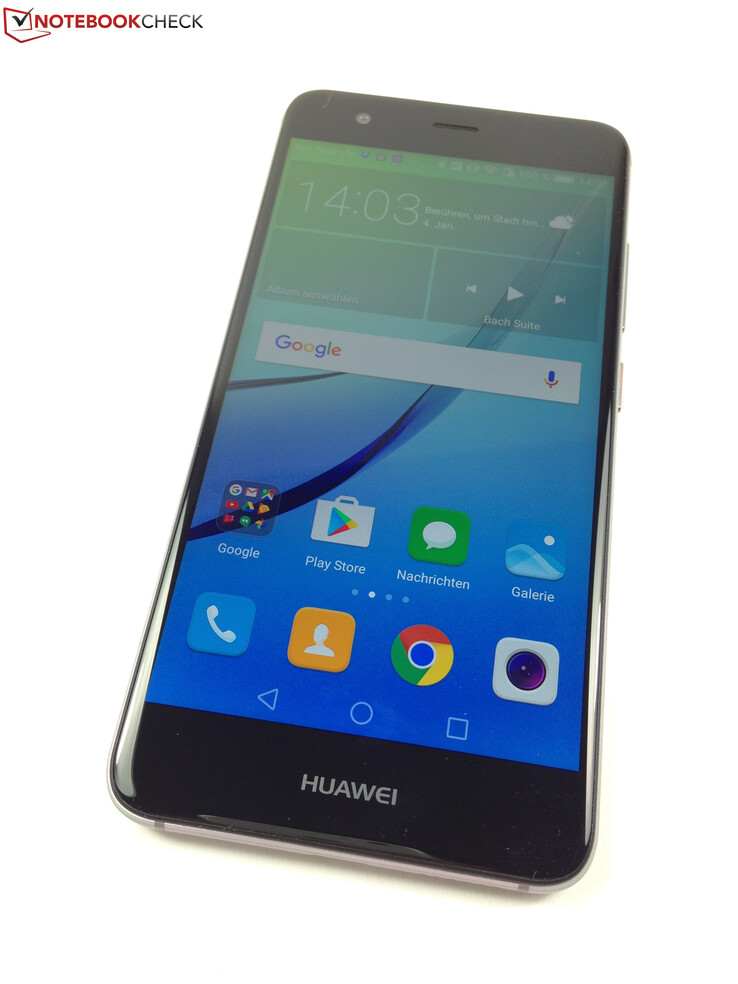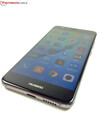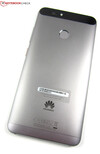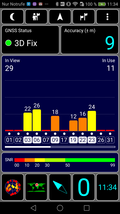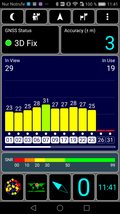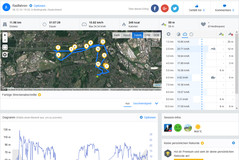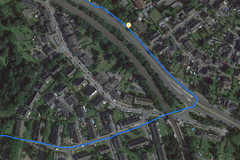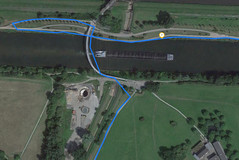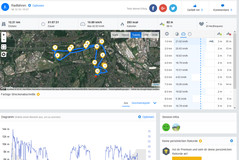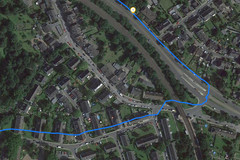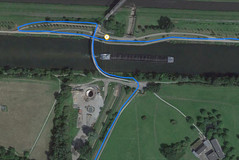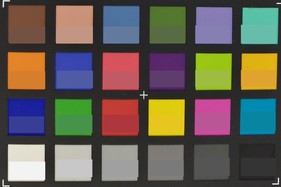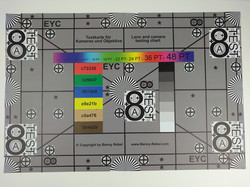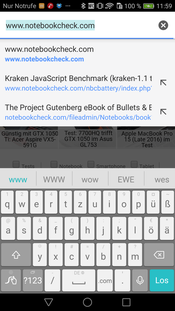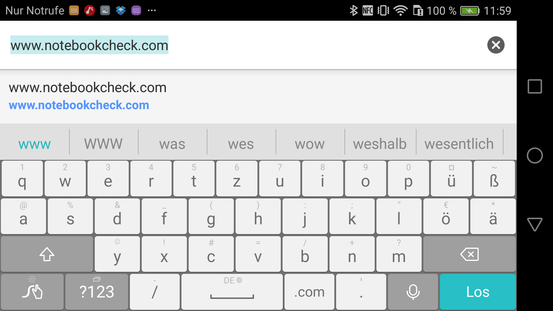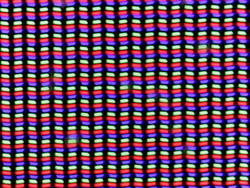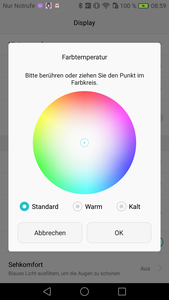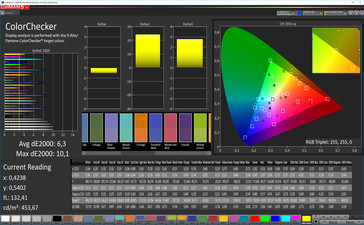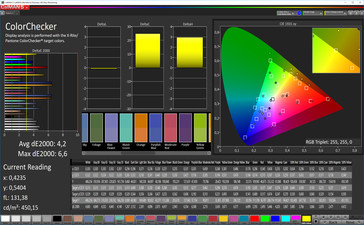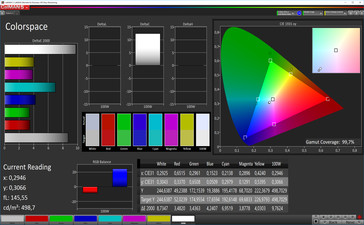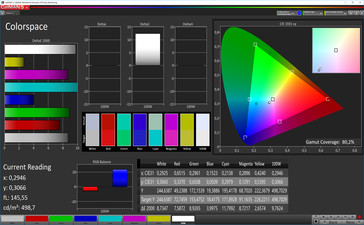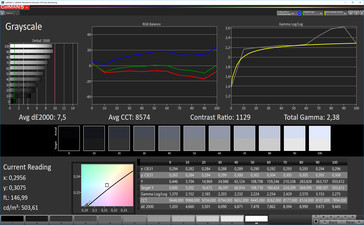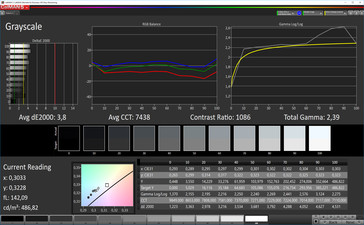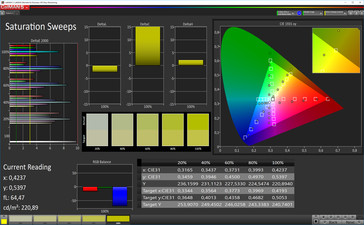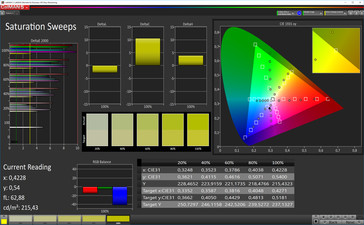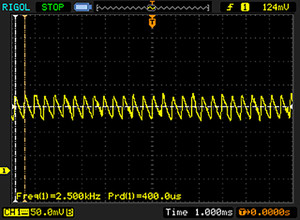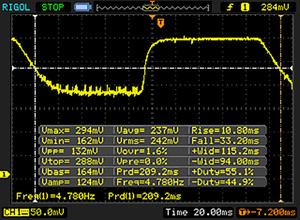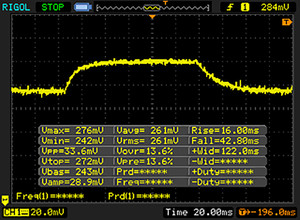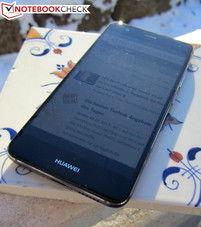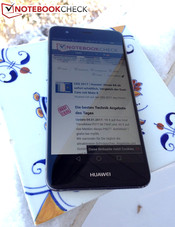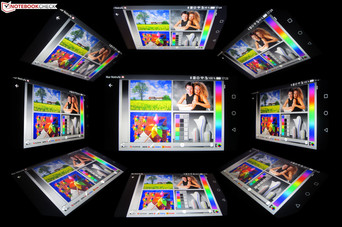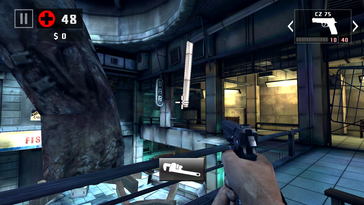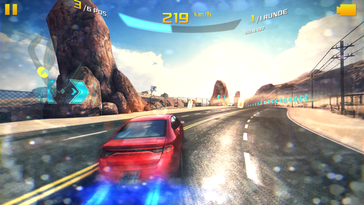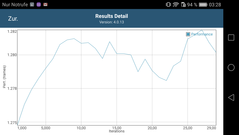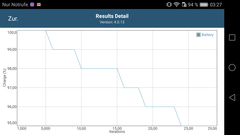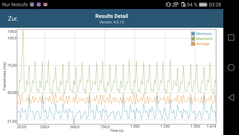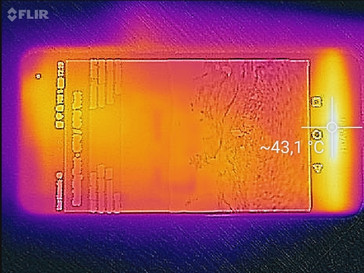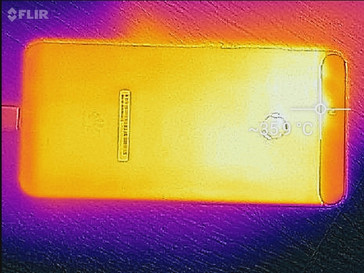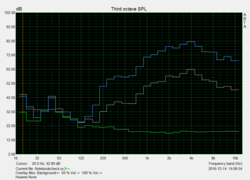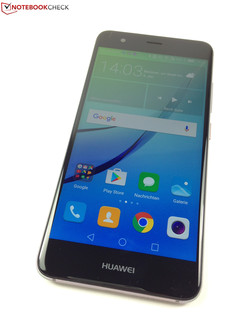Huawei Nova Smartphone Review

For the original German review, see here.
In addition to its 5.5-inch Nova Plus mid-range smartphone, Huawei also has the slightly smaller and approximately 80-Euro (~$85) cheaper 5-inch Nova sibling in its portfolio. The Android handsets are very identical apart from their screen size. Both offer a Full HD panel with 1920x1080 pixels, a fast Qualcomm Snapdragon 625 SoC, 3 GB of RAM, 32 GB of storage, and dual-SIM functionality. Like its bigger sibling, Huawei's Nova can also record videos in Ultra HD.
Then, there are some small differences: The 3020 mAh battery in Huawei's Nova is a bit smaller (Nova Plus: 3340 mAh), which will probably result in a shorter battery life in view of the same SoC. Instead of a 16-megapixel camera, the primary camera now only has 12 megapixels and also does not have an image stabilizer. In return, Huawei's Nova is somewhat thinner and lighter than the Nova Plus thanks to its smaller size. It is also available in three colors ("Titanium Gray", "Mystic Silver" and "Prestige Gold"), and it supports more UMTS radio frequencies.
To check just how well Huawei's Nova fares in the highly competitive mid-range sector, we compare it with similarly configured and identically priced smartphones in the forms of Lenovo's Moto Z Play, Samsung's Galaxy A5 (2016), Asus' ZenFone 3 ZE552KL, and ZTE's Axon 7. We naturally also compare its performance with that of Huawei's Nova Plus.
Case
Huawei packs the Nova in a very rigid metal unibody casing that not only has premium looks thanks to a matte surface and curved back but also has a high-quality feel. It looks a lot like Google's Nexus 6P. A so-called 2.5D glass front that is lightly rounded into the bezel covers the screen. Alongside the narrow gaps, the smartphone looks as if it has been made from one piece. The only drawback: The user cannot replace the lithium-polymer battery.
The power button and volume control on the right have well-defined pressure points and are easy to reach with a thumb. A fingerprint scanner is centered on the back. It is in a small recess, making it easy to locate and use.
The dual-SIM tray on the left can be furnished with either two nano-SIM cards or one SIM card and one micro-SD card with a maximum capacity of up to 128 GB.
Connectivity
Qualcomm's Snapdragon 625, built in the 14-nm structure width with eight ARM Cortex A53 cores that clock at up to 2 GHz, powers Huawei's Nova. Qualcomm's Adreno 506 is responsible for graphics processing. It has enough computing power for the latest generation of Android games. 3 GB of LPDDR3 RAM ensures a fast Android user experience. 22.7 GB of the nominal 32 GB internal storage is left ex-factory. According to the manufacturer, the smartphone can be furnished with a micro-SD card of up to 128 GB. However, this does not expand the storage as only photos and media files can be stored on the micro-SD card. Apps cannot be moved to it.
Huawei's Nova is equipped with a USB Type-C port that only supports USB 2.0 speeds. However, external storage devices and input devices can be connected via USB OTG. Further ports include Bluetooth 4.1 and NFC.
Software
The smartphone uses a fairly new version of 6.0 Marshmallow. Huawei extends it with its own EMUI 4.1 user interface (build-number: CAN-L01C432B100). According to the manufacturer, an update to Android 7.0 Nougat is planned but was not available at test time.
Extensive software extras are not found on the smartphone. In addition to the usual apps, such as Google tools, a small game collection and some software, such as Huawei's HiCare service app and WPS Office suit, are preloaded. Positive: Apart from Google's apps, almost all programs can be uninstalled and consequently do not reserve storage when they are unwanted.
Communication and GPS
Huawei's Nova is well-configured in terms of communication with GSM quad-band, UMTS quad-band, and LTE Cat.6 (bands 1, 3, 7, 8, 20, 38). The reception in 4G networks was always impeccable in the tests. Downloads of up to 300 MBit/s and uploads of up to 50 MBit/s are possible.
Huawei's Nova only supports the 802.11 b/g/n Wi-Fi standards, which excludes 5.0 GHz Wi-Fi. The smartphone had problems particularly when receiving data and more than a slow 20 MBit/s was not possible. Huawei's Nova Plus model, which does not support 5.0 GHz Wi-Fi either, is twice as fast here. Then again, Huawei's Nova quickly transmitted data in the 2.4 GHz network.
| Networking | |
| iperf3 transmit AX12 | |
| ZTE Axon 7 | |
| Lenovo Moto Z Play | |
| Huawei Nova Plus | |
| Huawei Nova | |
| Asus Zenfone 3 ZE552KL | |
| iperf3 receive AX12 | |
| ZTE Axon 7 | |
| Lenovo Moto Z Play | |
| Huawei Nova Plus | |
| Asus Zenfone 3 ZE552KL | |
| Huawei Nova | |
Huawei's Nova very accurately locates its position via GPS, GLONASS, and Beidou. The smartphone found us with an accuracy of 3 meters indoors, and this reduced to just one meter outdoors.
To test how well localization functions in practice, we took Huawei's Nova alongside Garmin's Edge 500 professional navigation system on an approximately 12-kilometer long bike ride. The smartphone did a good job in the direct comparison and proved that its navigation accuracy is absolutely sufficient for everyday use.
Telephone and Call Quality
Huawei has only modified the phone app very marginally compared with the stock Android version. As usual, it offers tabs for contacts and favorites beside a keypad. The call quality was beyond reproach in the test. Noise suppression functioned impeccably and both ends could understand each other very clearly. The intelligibility only decreased somewhat when using the speaker.
Cameras
The webcam furnished with a fix-focus in Huawei's Nova has a maximum resolution of 8 megapixels and shoots 3264x2448-pixel photos in the 4:3 format. The maximum resolution decreases to 6 megapixels in the 16:9 format (3264x1836 pixels). Videos can be recorded in Full HD.
The camera software has diverse functions for selfies. A make-up mode with nine different filters, such as natural, club, party or elegant, can be found. They cover the eyes, eyelashes, cheeks, forehead, and lips with effects in real-time and the results are really natural. Just as easy to use is the 10-level beauty-enhancer that allows selecting settings for the "perfect selfie" (smooth complexion, eye size and thinner face are among them). Furthermore, a magnifying mirror, brightness settings, and nine color filters for putting oneself in a good light are preloaded.
The primary camera is a 12-megapixel module (photos up to 4032x3016 pixels) that has an LED flash but, in contrast to Huawei's Nova Plus (16 megapixels), does not have an optical stabilizer. Despite this shortcoming, the smartphone does a good job. Photos look appealing thanks to their natural colors and they score with a high range of dynamics. The primary camera even produces high-detail photos in difficult light conditions. However, they look relatively unfocused when looking closer.
Once again, the extensive software is pleasing. The primary camera includes a professional mode in addition to standard photo modes, such as HDR and panorama. Important image parameters, such as light sensitivity, exposure times and white balance, can be set manually in the first. Like with Huawei's Nova Plus, videos can be recorded in UHD quality (3840x2160 pixels) with the Nova. However, more than 30 frames per second is not possible. In return, the sound is recorded in decent stereo quality. The auto-focus sometimes failed in the test and manual adjustments were necessary - but this was no tragedy in total.
We performed additional tests with Huawei's Nova under defined light conditions. The photos were not edited afterward. Huawei's Nova always reproduced colors a bit too vividly - although this is not particularly realistic, it looks good.
The sharpness of the photos can be evaluated well using our test chart. Huawei's Nova reproduces image details sharply in the center and color transitions are displayed very homogeneously. The contrast decreases clearly toward the edges. This effect is particularly visible in the lower half of the photos.
Accessories and Warranty
Huawei delivers its smartphone with a modular power supply, USB Type-C cable, SIM tool, headset, and quick-start guide. Nova-specific accessories are not listed on the manufacturer's website.
Huawei's Nova comes with a 24-month warranty. Please see our Guarantees, Return Policies & Warranties FAQ for country-specific information.
Input Devices and Handling
The capacitive touchscreen in Huawei's Nova detects up to 10 finger inputs at a time and responds quickly and accurately to all commands no matter where they are performed on the screen. The preloaded keyboard that Huawei covers with its own swipe layout also allows fast and accurate inputs using, for example, swipe gestures and speech. Users who do not like this keyboard can always install an alternative from Google's Play Store.
The rear-sided fingerprint scanner makes a good impression. The sensor identifies stored fingerprints quickly and unlocks the smartphone fast. The physical keys hardly have play toward the sides of their recess, and their accurate pressure point conveys a high-quality impression.
Display
The 5-inch IPS panel in Huawei's Nova has a resolution of 1920x1080 pixels. This equals a pixel density of 443 PPI, which results in a razor-sharp image reproduction. The Nova has more than enough brightness reserves with a maximum of 493 cd/m². The maximum brightness of 489 cd/m² in the measurement with evenly distributed bright and dark image areas (Average Picture Level 50 / APL50) is only insignificantly lower.
The very homogeneous illumination of 90% and the high contrast ratio of 1120:1 are also good. Subjectively, this is seen in a crisp and vivid color reproduction. However, we ascertained screen flickering (PWM) that was only evident when the screen's brightness was set to minimum. This should be a rare case in everyday use, though.
| |||||||||||||||||||||||||
Brightness Distribution: 94 %
Center on Battery: 493 cd/m²
Contrast: 1120:1 (Black: 0.44 cd/m²)
ΔE ColorChecker Calman: 4.2 | ∀{0.5-29.43 Ø4.77}
ΔE Greyscale Calman: 3.8 | ∀{0.09-98 Ø5}
Gamma: 2.39
CCT: 7438 K
| Huawei Nova IPS, 1920x1080, 5" | Lenovo Moto Z Play AMOLED, 1920x1080, 5.5" | Asus Zenfone 3 ZE552KL IPS, 1920x1080, 5.5" | ZTE Axon 7 AMOLED, 2560x1440, 5.5" | Samsung Galaxy A5 2016 Super AMOLED, 1920x1080, 5.2" | Huawei Nova Plus IPS, 1920x1080, 5.5" | |
|---|---|---|---|---|---|---|
| Screen | 19% | -13% | -30% | 18% | -10% | |
| Brightness middle (cd/m²) | 493 | 509 3% | 658 33% | 328 -33% | 378 -23% | 485 -2% |
| Brightness (cd/m²) | 485 | 511 5% | 633 31% | 334 -31% | 380 -22% | 481 -1% |
| Brightness Distribution (%) | 94 | 93 -1% | 93 -1% | 88 -6% | 91 -3% | 90 -4% |
| Black Level * (cd/m²) | 0.44 | 0.66 -50% | 0.5 -14% | |||
| Contrast (:1) | 1120 | 997 -11% | 970 -13% | |||
| Colorchecker dE 2000 * | 4.2 | 2.2 48% | 4.9 -17% | 4.6 -10% | 1.95 54% | 4.2 -0% |
| Colorchecker dE 2000 max. * | 6.6 | 5.8 12% | 9.1 -38% | 14.7 -123% | 3.09 53% | 7.9 -20% |
| Greyscale dE 2000 * | 3.8 | 2 47% | 5.8 -53% | 2.8 26% | 1.86 51% | 4.8 -26% |
| Gamma | 2.39 92% | 2.25 98% | 2.26 97% | 2.29 96% | 2.13 103% | 2.36 93% |
| CCT | 7438 87% | 6768 96% | 7840 83% | 6612 98% | 6376 102% | 7568 86% |
* ... smaller is better
The image reproduction can be adapted in the screen's settings. The "Eye Comfort" model filters out the blue light fraction of an image to prevent eye strain when using the smartphone in dark environments. The menu item "Color temperature" allows further settings. In addition to the three predefined color temperature profiles, standard, warm and cool, a color wheel can be used to modify the color temperature freely.
As the analysis using the spectrophotometer and CalMAN software shows, Huawei's Nova is clearly off track in the standard color temperature profile. Both the grayscale levels and mixed colors surpass the ideal value of DeltaE < 3 evidently. The screen looks more balanced when selecting the warm color profile (maximum DeltaE of 4.2). These irregularities will not be noticed in everyday use.
Screen Flickering / PWM (Pulse-Width Modulation)
| Screen flickering / PWM detected | 2500 Hz | ≤ 1 % brightness setting | |
The display backlight flickers at 2500 Hz (worst case, e.g., utilizing PWM) Flickering detected at a brightness setting of 1 % and below. There should be no flickering or PWM above this brightness setting. The frequency of 2500 Hz is quite high, so most users sensitive to PWM should not notice any flickering. In comparison: 53 % of all tested devices do not use PWM to dim the display. If PWM was detected, an average of 8083 (minimum: 5 - maximum: 343500) Hz was measured. | |||
Display Response Times
| ↔ Response Time Black to White | ||
|---|---|---|
| 44 ms ... rise ↗ and fall ↘ combined | ↗ 10.8 ms rise | |
| ↘ 33.2 ms fall | ||
| The screen shows slow response rates in our tests and will be unsatisfactory for gamers. In comparison, all tested devices range from 0.1 (minimum) to 240 (maximum) ms. » 98 % of all devices are better. This means that the measured response time is worse than the average of all tested devices (20.2 ms). | ||
| ↔ Response Time 50% Grey to 80% Grey | ||
| 58.8 ms ... rise ↗ and fall ↘ combined | ↗ 16 ms rise | |
| ↘ 42.8 ms fall | ||
| The screen shows slow response rates in our tests and will be unsatisfactory for gamers. In comparison, all tested devices range from 0.165 (minimum) to 636 (maximum) ms. » 95 % of all devices are better. This means that the measured response time is worse than the average of all tested devices (31.6 ms). | ||
High brightness plus high contrast ratio - this combination makes Huawei's Nova ideal for outdoor use. Legibility is only impaired in direct sunlight. However, all smartphones struggle with this problem.
Huawei's Nova does not present any weaknesses in viewing-angle stability. As expected, the image on the IPS panel does not invert or display significant brightness losses even from very flat angles.
Performance
Huawei furnishes the Nova with Qualcomm's Snapdragon 625 that is powered by eight energy-saving Cortex A53 cores and can fall back on 3 GB of LPDDR3 RAM. Exactly this configuration of an octa-core processor and storage capacity is also found in Huawei's Nova Plus, Lenovo's Moto Z Play, and Asus' ZenFone 3 ZE552KL. Consequently, all devices are roughly on par in the synthetic benchmarks. However, ZTE's Axon 7 wins by a nose in total.
| AnTuTu v6 - Total Score (sort by value) | |
| Huawei Nova | |
| Lenovo Moto Z Play | |
| Asus Zenfone 3 ZE552KL | |
| ZTE Axon 7 | |
| Samsung Galaxy A5 2016 | |
| Huawei Nova Plus | |
| Geekbench 4.0 | |
| 64 Bit Single-Core Score (sort by value) | |
| Huawei Nova | |
| Lenovo Moto Z Play | |
| Asus Zenfone 3 ZE552KL | |
| ZTE Axon 7 | |
| Huawei Nova Plus | |
| 64 Bit Multi-Core Score (sort by value) | |
| Huawei Nova | |
| Lenovo Moto Z Play | |
| Asus Zenfone 3 ZE552KL | |
| ZTE Axon 7 | |
| Huawei Nova Plus | |
| GFXBench (DX / GLBenchmark) 2.7 | |
| T-Rex Onscreen (sort by value) | |
| Huawei Nova | |
| Lenovo Moto Z Play | |
| Asus Zenfone 3 ZE552KL | |
| ZTE Axon 7 | |
| Samsung Galaxy A5 2016 | |
| Huawei Nova Plus | |
| 1920x1080 T-Rex Offscreen (sort by value) | |
| Huawei Nova | |
| Lenovo Moto Z Play | |
| Asus Zenfone 3 ZE552KL | |
| ZTE Axon 7 | |
| Samsung Galaxy A5 2016 | |
| Huawei Nova Plus | |
| GFXBench 3.0 | |
| on screen Manhattan Onscreen OGL (sort by value) | |
| Huawei Nova | |
| Lenovo Moto Z Play | |
| Asus Zenfone 3 ZE552KL | |
| ZTE Axon 7 | |
| Samsung Galaxy A5 2016 | |
| Huawei Nova Plus | |
| 1920x1080 1080p Manhattan Offscreen (sort by value) | |
| Huawei Nova | |
| Lenovo Moto Z Play | |
| Asus Zenfone 3 ZE552KL | |
| ZTE Axon 7 | |
| Samsung Galaxy A5 2016 | |
| Huawei Nova Plus | |
| GFXBench 3.1 | |
| on screen Manhattan ES 3.1 Onscreen (sort by value) | |
| Huawei Nova | |
| Lenovo Moto Z Play | |
| Asus Zenfone 3 ZE552KL | |
| ZTE Axon 7 | |
| Huawei Nova Plus | |
| 1920x1080 Manhattan ES 3.1 Offscreen (sort by value) | |
| Huawei Nova | |
| Lenovo Moto Z Play | |
| Asus Zenfone 3 ZE552KL | |
| ZTE Axon 7 | |
| Huawei Nova Plus | |
| PCMark for Android - Work performance score (sort by value) | |
| Huawei Nova | |
| Lenovo Moto Z Play | |
| Asus Zenfone 3 ZE552KL | |
| ZTE Axon 7 | |
| Samsung Galaxy A5 2016 | |
| Huawei Nova Plus | |
Browsing on the Internet with Huawei's Nova is very fast subjectively. The benchmarks also confirm this. Huawei's Nova achieves good scores starting with Octane 2.0 over Mozilla Kraken 1.1 up to JetStream 1.1 and is on par with Asus' ZenFone 3 ZE552KL and Lenovo's Moto Z Play. Samsung's Galaxy A5 (2016) is not quite as fast, while ZTE's Axon 7 takes the first place here.
| Octane V2 - Total Score (sort by value) | |
| Huawei Nova | |
| Lenovo Moto Z Play | |
| Asus Zenfone 3 ZE552KL | |
| ZTE Axon 7 | |
| Samsung Galaxy A5 2016 | |
| Huawei Nova Plus | |
| Mozilla Kraken 1.1 - Total (sort by value) | |
| Huawei Nova | |
| Lenovo Moto Z Play | |
| Asus Zenfone 3 ZE552KL | |
| ZTE Axon 7 | |
| Samsung Galaxy A5 2016 | |
| Huawei Nova Plus | |
| WebXPRT 2015 - Overall (sort by value) | |
| Huawei Nova | |
| Lenovo Moto Z Play | |
| Asus Zenfone 3 ZE552KL | |
| ZTE Axon 7 | |
| Samsung Galaxy A5 2016 | |
| Huawei Nova Plus | |
| JetStream 1.1 - Total Score (sort by value) | |
| Huawei Nova | |
| Lenovo Moto Z Play | |
| Asus Zenfone 3 ZE552KL | |
| ZTE Axon 7 | |
| Samsung Galaxy A5 2016 | |
| Huawei Nova Plus | |
* ... smaller is better
The 32 GB eMMC storage in Huawei's Nova is fast and even a bit faster than that in Huawei's Nova Plus. The same is presented in the micro-SD's performance. Although Huawei's Nova cannot completely exhaust the speed potential of our Toshiba Exceria Pro M401 reference card, it achieves the same good results of the smartphones by Asus, Lenovo, and ZTE. Huawei's Nova Plus first follows at some distance.
| Huawei Nova | Lenovo Moto Z Play | Asus Zenfone 3 ZE552KL | ZTE Axon 7 | Samsung Galaxy A5 2016 | Huawei Nova Plus | |
|---|---|---|---|---|---|---|
| AndroBench 3-5 | 1% | 30% | 54% | -38% | -19% | |
| Sequential Read 256KB (MB/s) | 248.3 | 254.8 3% | 282 14% | 406.5 64% | 209.4 -16% | 241.6 -3% |
| Sequential Write 256KB (MB/s) | 75 | 73.1 -3% | 188 151% | 150.9 101% | 60.4 -19% | 82.1 9% |
| Random Read 4KB (MB/s) | 38.19 | 38.78 2% | 74 94% | 121.1 217% | 22.9 -40% | 35.64 -7% |
| Random Write 4KB (MB/s) | 44.63 | 45.58 2% | 7.4 -83% | 16.22 -64% | 11.2 -75% | 30.12 -33% |
| Sequential Read 256KB SDCard (MB/s) | 79.5 | 74.6 -6% | 79.2 0% | 78.4 -1% | 41.64 -48% | |
| Sequential Write 256KB SDCard (MB/s) | 47.69 | 50.6 6% | 50.1 5% | 51.3 8% | 33.32 -30% |
Games
The Adreno 506 graphics chip integrated into the SoC is not a performance marvel, but it supports modern APIs like OpenGL 3.2 and Direct3D 12. It also renders demanding Android games, such as Asphalt 8: Airborne or Dead Trigger, smoothly even when the image details are set to maximum. The other hardware does not ruin gaming fun, either. The touchscreen responds accurately and the sensors function impeccably.
| Asphalt 8: Airborne | |||
| Settings | Value | ||
| high | 30 fps | ||
| very low | 30 fps | ||
| Dead Trigger 2 | |||
| Settings | Value | ||
| high | 53 fps | ||
Emissions
Temperature
The surface temperatures of Huawei's Nova only surpass 40 °C in single areas and are thus absolutely uncritical. The smartphone fortunately does not have to use tricks like throttling to achieve these harmless rates. The frame rates remained stable in the GFXBench battery test that performs a graphics benchmark 30 times in succession.
(±) The maximum temperature on the upper side is 41.4 °C / 107 F, compared to the average of 35.2 °C / 95 F, ranging from 21.9 to 247 °C for the class Smartphone.
(+) The bottom heats up to a maximum of 35.1 °C / 95 F, compared to the average of 34 °C / 93 F
(±) In idle usage, the average temperature for the upper side is 32.9 °C / 91 F, compared to the device average of 32.9 °C / 91 F.
Speaker
The mono speaker in Huawei's Nova is situated on the USB port's left and can produce an amazingly high volume of 88 dB(A) without distorting. Subjectively, the sound is even surprisingly powerful when the volume is not turned up to maximum. The trebles audibly dominate at maximum volume while mid and low tones are virtually inaudible. Then, the output via the 3.5-mm headset jack is very balanced.
Huawei Nova audio analysis
(+) | speakers can play relatively loud (88.3 dB)
Bass 100 - 315 Hz
(-) | nearly no bass - on average 31.8% lower than median
(±) | linearity of bass is average (12.3% delta to prev. frequency)
Mids 400 - 2000 Hz
(±) | reduced mids - on average 7.6% lower than median
(+) | mids are linear (5.9% delta to prev. frequency)
Highs 2 - 16 kHz
(±) | higher highs - on average 7.5% higher than median
(+) | highs are linear (5.2% delta to prev. frequency)
Overall 100 - 16.000 Hz
(±) | linearity of overall sound is average (26% difference to median)
Compared to same class
» 65% of all tested devices in this class were better, 6% similar, 28% worse
» The best had a delta of 11%, average was 35%, worst was 134%
Compared to all devices tested
» 79% of all tested devices were better, 4% similar, 16% worse
» The best had a delta of 4%, average was 24%, worst was 134%
Asus Zenfone 3 ZE552KL audio analysis
(+) | speakers can play relatively loud (83.7 dB)
Bass 100 - 315 Hz
(-) | nearly no bass - on average 33% lower than median
(±) | linearity of bass is average (9.9% delta to prev. frequency)
Mids 400 - 2000 Hz
(+) | balanced mids - only 4% away from median
(+) | mids are linear (5.7% delta to prev. frequency)
Highs 2 - 16 kHz
(+) | balanced highs - only 2.8% away from median
(+) | highs are linear (6.1% delta to prev. frequency)
Overall 100 - 16.000 Hz
(±) | linearity of overall sound is average (21.7% difference to median)
Compared to same class
» 43% of all tested devices in this class were better, 8% similar, 49% worse
» The best had a delta of 11%, average was 35%, worst was 134%
Compared to all devices tested
» 61% of all tested devices were better, 7% similar, 32% worse
» The best had a delta of 4%, average was 24%, worst was 134%
Huawei Nova Plus audio analysis
(+) | speakers can play relatively loud (87.4 dB)
Bass 100 - 315 Hz
(-) | nearly no bass - on average 28.5% lower than median
(-) | bass is not linear (15.9% delta to prev. frequency)
Mids 400 - 2000 Hz
(+) | balanced mids - only 3.5% away from median
(+) | mids are linear (5% delta to prev. frequency)
Highs 2 - 16 kHz
(±) | higher highs - on average 5.7% higher than median
(+) | highs are linear (3.3% delta to prev. frequency)
Overall 100 - 16.000 Hz
(±) | linearity of overall sound is average (21.3% difference to median)
Compared to same class
» 41% of all tested devices in this class were better, 8% similar, 51% worse
» The best had a delta of 11%, average was 35%, worst was 134%
Compared to all devices tested
» 59% of all tested devices were better, 7% similar, 34% worse
» The best had a delta of 4%, average was 24%, worst was 134%
Frequency diagram in comparison (checkboxes above can be turned on/off)
Energy Management
Power Consumption
With approximately 5.2 watts during full load, Huawei's Nova is virtually just as energy-saving as its Nova Plus sibling. However, the maximum idle power consumption of Huawei's Nova could be a bit lower. Lenovo's Moto Z Play is by far the most efficient handset among the comparison devices.
Huawei's Nova is well-equipped with its 3020 mAh lithium-polymer battery. Although the smartphone does not explicitly support a quick-charge feature, its battery is recharged relatively fast. 2 hours and 15 minutes was needed to completely recharge the fully depleted battery in the test.
| Off / Standby | |
| Idle | |
| Load |
|
Key:
min: | |
| Huawei Nova 3020 mAh | Lenovo Moto Z Play 3510 mAh | Asus Zenfone 3 ZE552KL 3000 mAh | ZTE Axon 7 3250 mAh | Samsung Galaxy A5 2016 2900 mAh | Huawei Nova Plus 3340 mAh | |
|---|---|---|---|---|---|---|
| Power Consumption | 39% | -12% | -12% | -3% | 12% | |
| Idle Minimum * (Watt) | 0.61 | 0.51 16% | 0.83 -36% | 0.64 -5% | 0.96 -57% | 0.49 20% |
| Idle Average * (Watt) | 1.83 | 0.87 52% | 2.11 -15% | 0.84 54% | 1.64 10% | 1.63 11% |
| Idle Maximum * (Watt) | 1.86 | 0.9 52% | 2.12 -14% | 0.87 53% | 1.71 8% | 1.76 5% |
| Load Average * (Watt) | 3.71 | 1.69 54% | 3.41 8% | 6.02 -62% | 2.98 20% | 2.98 20% |
| Load Maximum * (Watt) | 5.19 | 4 23% | 5.46 -5% | 10.45 -101% | 5.08 2% | 4.99 4% |
* ... smaller is better
Battery Runtime
The comparatively low power consumption turns Huawei's Nova into a really enduring handset. The smartphone reaps in above average results in all battery test scenarios.
Although Huawei's Nova has a slightly smaller battery than Huawei's Nova Plus, its smaller screen saves energy. In total, both Huawei smartphones are equally enduring especially when looking at the real-world test (screen brightness set to 150 cd/m²).
Huawei's Nova lasts 14:33 hours in Internet browsing - a very good rate that none of the comparison devices surpass. The smartphone can be used for almost 12 hours when watching a Full HD video. Huawei's Nova Plus, Asus' ZenFone 3 ZE552KL, and Lenovo's Moto Z Play achieve even better video playback times. In total, the battery life does not give reason for complaint.
| Huawei Nova 3020 mAh | Lenovo Moto Z Play 3510 mAh | Asus Zenfone 3 ZE552KL 3000 mAh | ZTE Axon 7 3250 mAh | Samsung Galaxy A5 2016 2900 mAh | Huawei Nova Plus 3340 mAh | |
|---|---|---|---|---|---|---|
| Battery runtime | 48% | 1% | -22% | 9% | 4% | |
| Reader / Idle (h) | 31.2 | 42.3 36% | 25 -20% | 28.9 -7% | 38.7 24% | 34.1 9% |
| H.264 (h) | 12 | 19.8 65% | 15.1 26% | 11.7 -2% | 11.2 -7% | 12.2 2% |
| WiFi v1.3 (h) | 14.6 | 13.7 -6% | 13.3 -9% | 6.9 -53% | 10.4 -29% | 13.7 -6% |
| Load (h) | 5.5 | 10.9 98% | 5.9 7% | 4.1 -25% | 8.1 47% | 6.1 11% |
Pros
Cons
Verdict
Like Huawei's Nova Plus, Huawei's Nova is a really good smartphone with hardly any shortcomings. A very bright Full HD panel, high-quality and rigid casing, USB Type-C port, support for two SIM cards, and a reliable fingerprint scanner belong to its plus points. Although the 12-megapixel primary camera can only offer a slightly lower resolution than that of the Nova Plus and does not have an image stabilizer, it takes good photos and videos - the latter even in Ultra HD format, which is actually very rare in the mid-range. Despite its somewhat smaller battery, Huawei's Nova convinces with its long battery life. We also liked the radio module more than that of the Nova Plus as it supports more UMTS frequencies and is characterized by lower SAR rates.
Huawei has created a recommendable total package with its 5-inch Nova. The differences to the 80-Euro (~$85) more expensive Nova Plus are only marginal when disregarding the smaller screen.
We can adopt the cons list of Huawei's Nova Plus almost completely. Instead of two dedicated slots, only one hybrid slot that the SIM and micro-SD card have to share is installed. The Wi-Fi performance is fairly mixed due to the lack of 5 GHz network support. Furthermore, applications cannot be moved to the micro-SD card. Buyers who can live with these minor drawbacks and want to save 80 Euros (~$85) compared to Huawei's Nova Plus will find Huawei's Nova to be a recommendable smartphone that, according to its manufacturer, will soon be updated to Android 7 just like its 5.5-inch sibling.
Huawei Nova
- 01/09/2017 v6 (old)
Manuel Masiero


